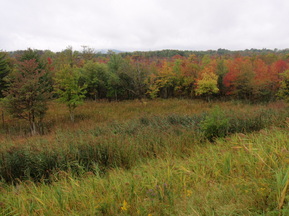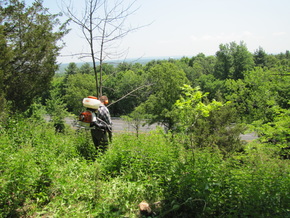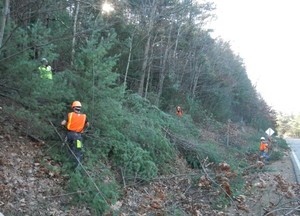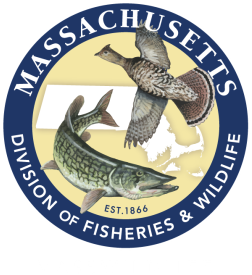Habitat Restoration
MassDOT and MassWildlife are implementing
habitat management programs to enhance, protect, and restore degraded lands
adjacent to highway rights-ofway that provide habitat for rare species.
Management activities range from the removalof invasive plants, torestoration
of basking habitat for state protected snakes, to roadside habitat restoration
for a state protected moth. These habitat projects align with the Highway
Division’s GreenDOT goal to enhance the ecological performance of MassDOT
impacted land in conjunction with MassWildlife’s fish and wildlife conservation
mission.
Not only do plant or wildlife communities benefit from this program, but some management actions also address public safety issues. One example is a restoration project designed to benefit the Orange Sallow Moth (Pyrrhia aurantiago), a state-listed invertebrate that feeds on the false foxglove plant. The habitat restoration activity required removing small to medium-size trees along a steep slope to provide the open woodland habitat the moth and its host plant require. This action also prevents trees from falling into the roadway during storm events.
Another collaborative habitat restoration project is underway at the Agawam Lake Wildlife Management Area (WMA) located in Great Barrington and Stockbridge and bisected by Route 7, a state highway. One portion of Agawam Lake WMA includes calcareous wetlands that are home to many rare and imperiled species of plants and wildlife. Calcareous wetlands are extremely rare in Massachusetts, and the Calcareous Basin Fen at Agawam Lake is considered to be one of the best examples of this plant community in the state.
Agawam Lake also supports one of the Commonwealth’s best examples of the unusual, imperiled, Black Ash-Red Maple-Tamarack Calcareous Seepage Swamp Community. Within these communities are several important occurrences of a diverse group of state-listed, watch-listed, and more common calciphilic (lime-loving) plants, along with various species of secretive marsh birds. Unfortunately, this unusual wetland is threatened by the presence of the highly invasive exotic plant Phragmites australis, also known as the Giant Reed. The MassWildlife/MassDOT partnership is targeting this non-native invasive and hasbeen conductingremovaloperations on over 40 acres with a goal of restoring thehabitat and maintainingthebiodiversity of one of the Commonwealth’s most important wetlands.
Not only do plant or wildlife communities benefit from this program, but some management actions also address public safety issues. One example is a restoration project designed to benefit the Orange Sallow Moth (Pyrrhia aurantiago), a state-listed invertebrate that feeds on the false foxglove plant. The habitat restoration activity required removing small to medium-size trees along a steep slope to provide the open woodland habitat the moth and its host plant require. This action also prevents trees from falling into the roadway during storm events.
Another collaborative habitat restoration project is underway at the Agawam Lake Wildlife Management Area (WMA) located in Great Barrington and Stockbridge and bisected by Route 7, a state highway. One portion of Agawam Lake WMA includes calcareous wetlands that are home to many rare and imperiled species of plants and wildlife. Calcareous wetlands are extremely rare in Massachusetts, and the Calcareous Basin Fen at Agawam Lake is considered to be one of the best examples of this plant community in the state.
Agawam Lake also supports one of the Commonwealth’s best examples of the unusual, imperiled, Black Ash-Red Maple-Tamarack Calcareous Seepage Swamp Community. Within these communities are several important occurrences of a diverse group of state-listed, watch-listed, and more common calciphilic (lime-loving) plants, along with various species of secretive marsh birds. Unfortunately, this unusual wetland is threatened by the presence of the highly invasive exotic plant Phragmites australis, also known as the Giant Reed. The MassWildlife/MassDOT partnership is targeting this non-native invasive and hasbeen conductingremovaloperations on over 40 acres with a goal of restoring thehabitat and maintainingthebiodiversity of one of the Commonwealth’s most important wetlands.




